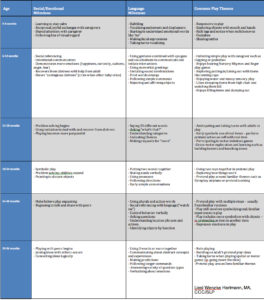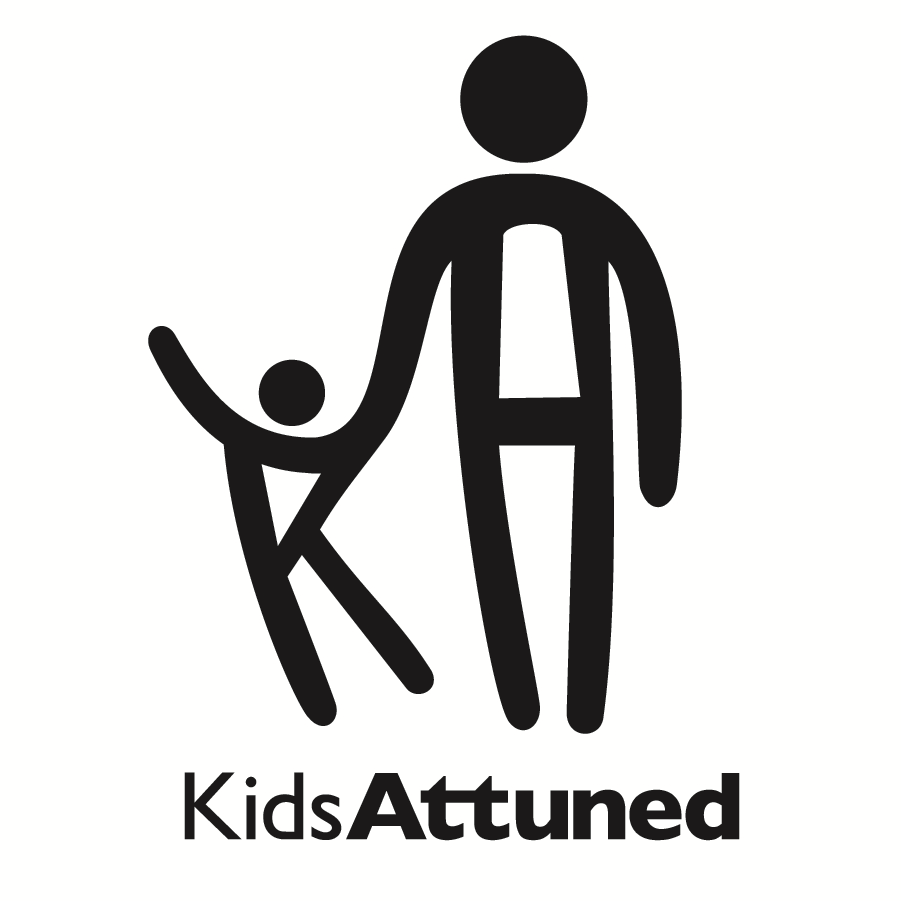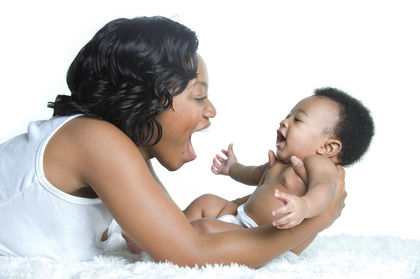Communication in Context: FIRST YEAR OF LIFE 0 – 12 MONTHS
The Interweaving of Language, Social and Play Development in Infants and Toddlers
Infancy and toddlerhood are fascinating periods of time full of rich developmental work crucial for future learning. Typically, infants are soaking up the language and experiences around them and toddlers are bursting with new vocabulary and ideas. When language, social and play systems are aligned, this is a time of incredible, creative growth.
But they’re not always aligned. When social-emotional development lags, it can hamper language development. To address this, adults must understand the relationship between language development and social-emotional development. The following delineates what to expect at each age from infancy to toddlerhood, and how social-emotional development nurtures language development.
Hand in Hand
Language development and social-emotional development go hand in hand. Functional language development involves much more than spoken words. It hinges on the social-emotional milestones through which infants and toddlers must progress to become effective communicators. This is an important concept to understand because when an infant or toddler’s foundational capacity to take in and act on social information and cues is affected or impaired, so is language development. And when language is assessed and treated without regard for social-emotional development, it can limit the child’s ability to effectively and naturally use the discrete language skills they have been taught.
The typical course of development occurs within the rich, playful interactions between the child and adult. These playful interactions are where the child gets the opportunities to practice and develop both social-emotional and language learning. Carefully observing a child’s play patterns gives us good information about the child’s current, overall cognitive, social and language development. This understanding then offers a roadmap for adults to meet the child where they are and then build on those capacities to then further the child’s abilities.
Consider These Ages and Developmental Milestones
Birth to 6 months – Regulation, Shared Attention and Affective Exchanges
In the first six months of life, parents may not think of their child as “having language”. However this period is actually extremely important in building reciprocal language skills. Babies in their first few months of life learn the highly important skill of staying calm and regulated in an environment full of stimulation. The ability to be calm and take in information is necessary for the baby to be able to focus on their caregiver and begin the foundational work to learn language and play abilities.
Pre-verbal communication is all about starting to connect with others in an emotional give and take. Babies at this stage are beginning to understand the intentions and feelings of the adults in their lives through emerging early capacities for sharing attention – the ability to pay attention to someone and notice that they are paying attention to us.
Shared Attention
The following video clip shows us examples of this seemingly simple, but highly important capacity for babies to share attention with a caregiver. Notice how the baby’s attention to the adult shifts when the adult pays attention to the baby – it is evident in her facial expression that she feels the attention and connection from her father and is ready to engage in a back-and-forth exchange with him:
This ability to share attention is a crucial early step in the ability to understand and to use language. Babies more readily attend to their parents when emotional cues are strong, so it should be no surprise that the first words babies tend to understand are those delivered to them with high affect and emotion. These are words parents commonly use with feelings attached to them, for example “1-2-3!” – said with excitement and anticipation – as well as the word “no!” – often said with force and perhaps anger or irritation. Conversely, babies also express themselves with emotions at this stage: They laugh when happy, cry when sad and grunt to get what they want. They are, in fact, communicating many needs, desires and emotions before using spoken language. Therefore it makes sense that using affect when teaching language to children is crucial – as is responding to the emotions that children express.
Social Anticipation and Joint Attention
The following video clip shows a 6 month old playing a simple game with a parent in which the parent shines sparkly reflections on the wall and makes silly noises that are fun and exciting for this baby. The parent then uses high affect when saying “1-2-3!” Note that the baby begins to tune in to those words and starts to learn that “1-2-3” means something exciting is about to happen. The baby also shows an ability to join attention with the parent, shift attention to something in the environment, and then join attention with the parent again, recognizing the parent is attending to the same thing. This “joint attention,” along with the baby’s ability to learn a back and forth routine and anticipate what will happen next, is another foundational step in becoming an effective communicator. Also of note, as the parent counts aloud “1… 2… 3” with high affect the baby shows an early understanding of back and forth exchanges by vocalizing in the pause between counts. This is yet another example of how learning to talk is about much more than words.
Generally, in parent-infant play, we see that babies are beginning to study the relationship between events. They are very responsive to and curious about what is going on around them. The games infants prefer at this stage when they share attention with others, such as peekaboo or exchanging silly noises and actions with caregivers, give them many chances to develop and practice in three important areas: becoming more purposeful with their actions, learning to understand the intentions of others, and being able to stay regulated in the midst of exciting experiences.
6 – 12 months – Social Referencing, Gesturing and First Words:
Between 6 and 12 months, joint and shared attention continue to build and lead to a further ability make decisions based on the information gathered from adults’ reactions and facial expressions. This ability, termed “social referencing”, is critical for future learning and communication.
Social Referencing
As social comprehension builds, an infant’s ability to understand expressions and gestures and to decipher their meanings leads babies to become even more intentional in their communication. This is where gesturing comes in. Many babies first learn to imitate movements and become more purposeful with their bodies through simple songs and nursery rhymes. This leads to more communicative gestures such as reaching upward as a request to be lifted, waving “hi” and “bye,” pointing to items of interest, and showing items to others by extending their arm while holding the object.
Using Gestures
The following clip shows an 8-month-old baby sharing the patty-cake song with a caregiver, and starting to pair gestures with the song. The learning happens within the context of the parent-child interaction and, although the gestures are not fully developed and clear, the parent ascribes meaning to the clapping and the child learns that clapping goes along with the patty-cake song. He is now on the road to becoming more intentional and meaningful with his gestures.
The use of gestures is a hallmark that a child is on the typical path of language and social-emotional development. This is where an observer can clearly see the intersection of these two areas developing in tandem. Simple gestures like clapping and waving lay the ground work for more sophisticated gestures, such as pointing. The child sees an airplane, looks up, points, and looks to see if the adult is also looking up to notice the airplane. It’s the intent to share the joy of the moment and to see the reaction of their communication partner that drives the gesture. Without the intention to share motivation with someone else, a toddler isn’t motivated to point to an object of interest and down the road is not likely to use words to comment or share information.
Along with the remarkable development of the use of gestures, by the end of a child’s first year many more markers of language emerge – and always, they develop interdependently with social-emotional development. Most notable are spoken words themselves. Many babies say “mama” or “dada” by this age and are frequently vocalizing with the intent to communicate, even if they don’t have access to words yet. The imitation of simple sound combinations, such as animal sounds, begin to manifest with ease.
As words develop, so too does a child’s comprehension. A 12 month old not only waves in response to “bye-bye”, but also stops when their name is called. They attend to the speaker, give objects to the speaker when asked and can follow some simple commands, such as identifying their body parts.
First Conversations
In the following video clip, a 12 month old gestures, makes eye contact, moves his body and speaks a word to interact with his parent about an item of high interest, a table fan. Notice how he’s able to participate fully in this interaction by commenting, answering questions and making requests with the use of gestures. The toddler uses just one word during the exchange, yet it feels like a conversation has occurred.
Play at 12 months demonstrates the child’s growing understanding of their influence on their surroundings. They perform simple actions to make things happen, like handing a windup toy to an adult to be activated again. Their enjoyment of finger play and nursery rhymes leads to many back and forth interactions with adults and opportunities to learn language and the rhythm of verbal exchanges. These seemingly simple games and interactions are actually setting the groundwork that is crucial and foundational to all further childhood development.
Sources:
Gerber, S. Developmental-pragmatic approaches/strategies. In F. Volkmar (Ed.), Encyclopedia of Autism Spectrum Disorders, 2013
Greenspan, Stanley and Weider, Serena. The Child with Special Needs. Cambridge, Massachusetts: Perseus, 1998
Lahey, Margaret. Language Disorders and Language Development. New York: Macmillan, 1988
Prizant, Barry, et al. The SCERTS Model; A Comprehensive Approach for Children on the Autism Spectrum. Baltimore: Brookes, 2006
Rossetti, Louis. The Rossetti Infant-Toddler Language Scale. East Moline, IL: LinguiSystems, 2005
Weitzman, E. and Greenberg, J. Learning Language and Loving It: A guide to promoting children’s social, language and literacy development in early childhood settings. Toronto: The Hanen Centre, 2002
Wetherby, Amy and Prizant, Barry. Autism Spectrum Disorders: A Transactional Perspective Baltimore: Brookes, 2000
Social Communication Birth to Three

Enter the text or HTML code here

